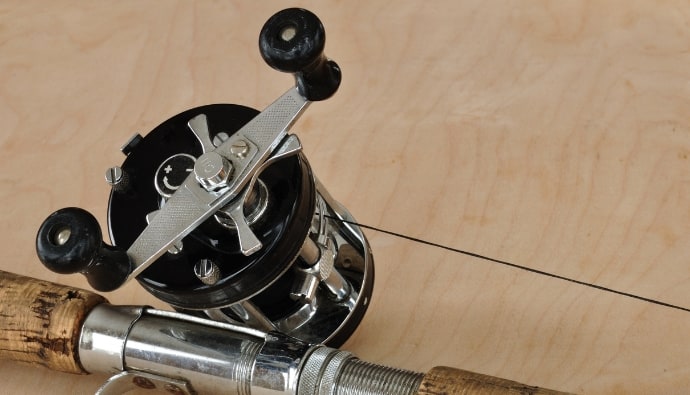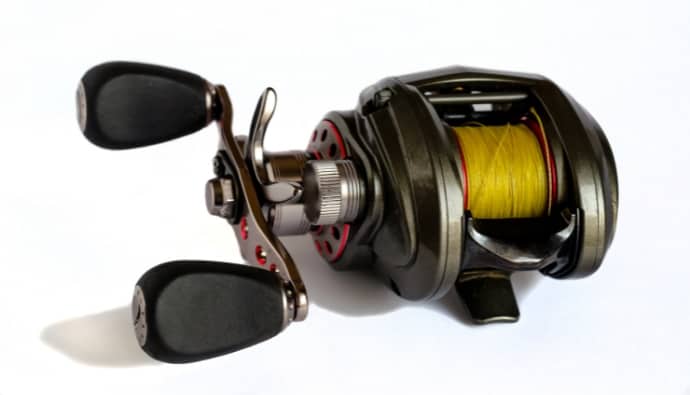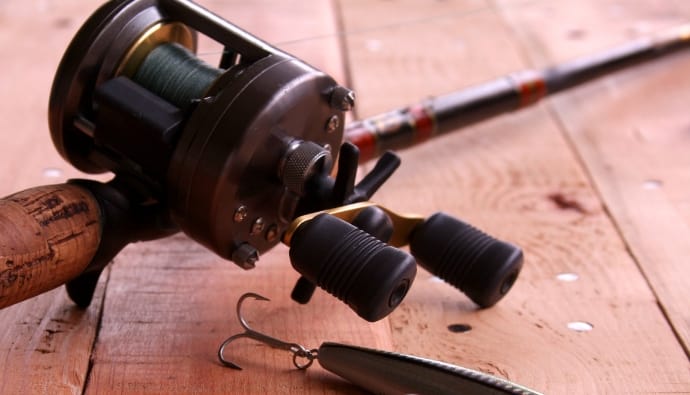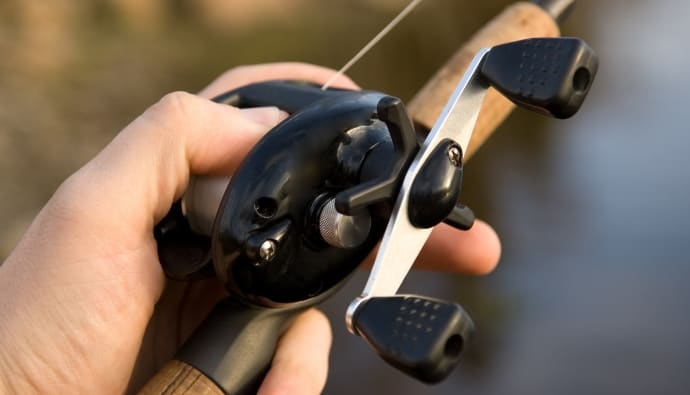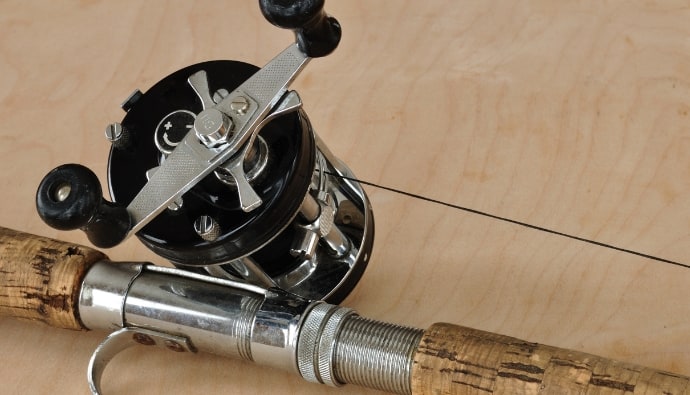Spinning reels and conventional reels are the two central fishing reels, each with unique characteristics and advantages. One similarity between a spinning and conventional reel is that they can be used for fresh and saltwater fishing. Some of their differences include that a spinning reel may be lighter and easy to use compared to a conventional reel, while a conventional reel has a more powerful drag system than a spinning reel.
Both conventional and spinning reels are practical tools for different fishing situations. Choosing a fishing reel depends on your target fish, fishing technique, and personal preference. It’s all a matter of selecting the one that best meets your needs.
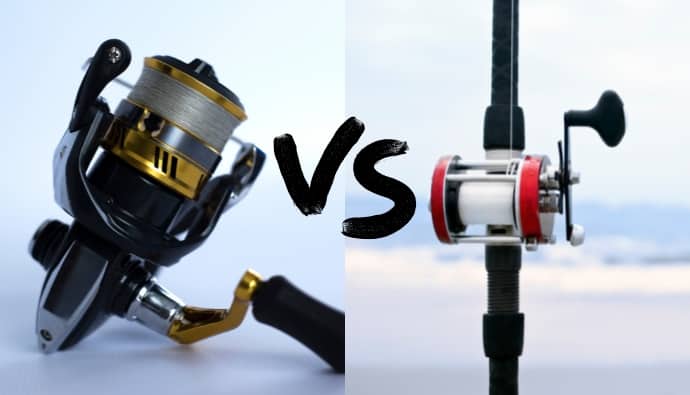
Spinning Reels
A spinning reel is a type of fishing reel that attaches to the bottom of a fishing rod. They consist of a stationary spool that sits perpendicular to the rod and is mounted on a metal housing.
Due to the mechanism, anglers have more control as they cast and retrieve the fishing line. You can use a spinning reel setup in freshwater and saltwater, as well as for various fishing types, including light tackle spinning for panfish and jigging or lure fishing for big fish like trout and steelhead.
How Spinning Reels Work
To use a spinning rod, the fisherman holds the line with the index finger to keep it taut, then casts the lines by turning the reel’s gears while angling the spinning rod forward. A bail arm, located on the top of the reel, opens and closes to control the line. Revolve the handle on the side of the reel to retrieve the line. This will spin the spool and wind the line back onto it.
Pros of Spinning Reels
Most anglers go for a spinning reel due to several reasons, including:
- Easy to use
- Lighter than most reels
- Easily available
- More drag power
- More affordable
Cons of Spinning Reels
Here are several potential downsides to using a spinning reel:
- Prone to tangling, especially when using heavier or bulkier fishing lines, which results in lost fish.
- They are highly susceptible to wear and tear due to the large number of moving parts they contain.
- More expensive
Conventional Reels
A conventional reel is a fishing reel mounted on the top of a fishing rod. It features a fixed spool and a revolving handle that must be cranked by hand to cast and retrieve the line. Also referred to as a baitcasting reel, these reel types are best known for smooth action and impressive casting distance.
Baitcasting reels are recommended for bass fishing using higher-weight baits. Casting rods are a great advantage when bottom fishing for striped bass and giant catfish or boat trolling for larger fish. A baitcaster reel, however, requires more skill to use compared to spinning reels.
How Conventional Reels Work
During the cast, the angler holds the rod with one hand and pulls back on the reel handle with the other hand. The spool rotates, and the line is released, allowing the bait or lure to be cast out.
The fisherman controls the amount of line released by adjusting the reel’s spool tension and braking system. The drag system controls the resistance the larger spool applies to the line while the brakes prevent the spool from over-rotating and releasing too much line.
When a fish bites the hook and begins to pull the line, the reel’s drag is engaged to apply resistance to the catch. The angler spins the handle in the opposite direction, which winds the line back onto the spool, reeling in the catch. A casting reel has a higher gear ratio than a spinning reel, which supports faster line retrieval.
Pros of Conventional Reels
Conventional reels are better than other types of reels due to the following:
- Greater casting distance and accuracy
- Better control and precision
- Powerful drag system, which allows for better control of a fighting fish.
- High durability
- Greater power, making these reels suitable for heavy-duty fishing.
- Better sensitivity to nibbles and bites.
Cons of Conventional Reels
A conventional reel has several potential drawbacks. These include:
- Require more skill and practice to master, making them difficult for newbies.
- Prone to bird’s nests
- They are heavy
- Higher cost
- Not suitable for all types of fishing
Comparison of Spinning Reels and Conventional Reels
When it comes to spinning and casting reels, there are a few key points of comparison to keep in mind:
| Spinning Reels | Conventional Reels | |
| Design | The spool lies parallel to the rod | Spool sits perpendicular to the rod |
| Casting | Use a fixed spool and a bail, which makes the casting process easier and more intuitive | The angler manually controls the spool to prevent overrun or backlash |
| Drag System | Have a rear drag system | Have a star type system |
| Line Capacity | Moderate capacity | High line capacity, which makes them better suited for targeting big fish and deep-sea fishing |
| Skill Level | Easy to use, making them the most popular type of fishing reel for beginners | More suited for experienced fishers because of the need to manually control the spool during casting |
| Application | Commonly used for freshwater fishing, light saltwater fishing, and trolling | Commonly used for deep sea fishing, big game fishing, and trolling |
| Cost | More affodable | More costly |
Conclusion
So, which reels are better? Ultimately, both reel types have pros and cons, so it’s essential to consider your desired application before deciding. A conventional reel is a way to go if you need to cast further and don’t require delicate presentations. But opt for a spinning reel if you’re after precision with the casts and lighter lures.
Note that spinning and baitcasting reels can complement each other. You could use a conventional reel for targeting big predators while also having a spinning reel with light baits on hand for smaller species.




 Facebook
Facebook YouTube
YouTube